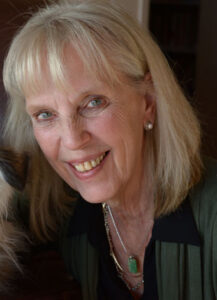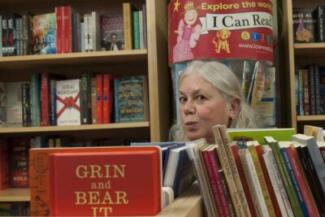A whimsical respite
Jigsaw: A Puzzle in Ninety-Three Pieces
by M.A.C. Farrant
Vancouver: Talonbooks, 2023
$19.95 / 9781772015430
Reviewed by Heidi Greco
*

January 29 was officially Puzzle Day, a fact I wouldn’t have known unless I’d read this enigmatic little book, the latest from North Saanich’s M.A.C. Farrant. Even though I qualify as being able to call myself a ‘puzzler’—one of many terms I learned while reading Jigsaw—I hadn’t had the pleasure of being this entertained by a book in some while.
The book is a compendium of delightfully quirky short pieces, each commenting on some aspect of puzzle-making. Although the author’s focus is primarily the joy of jigsaw puzzles, she does credit other kinds of brain workouts, from crossword puzzles through Sudoku. Still, it’s clear that Farrant’s real love in the world of puzzles is a jigsaw’s intricate demands.
Among those she praises most highly are the made-in-England laser-cut wooden puzzles made by Wentworth. Because I’d had the good fortune of finding my own Wentworth puzzle at a second-hand shop (where I paid the princely sum of $1.25), I was somewhat shocked when I went to that company’s website and saw their puzzles selling for well into the hundreds of English pounds. It was enough to make me get out my little puzzle of the staid-looking English castle and pat the box somewhat reverently on the surface of its guiding picture.
But the book is not a pitch for any puzzle company; it’s more an extended meditation on the many aspects of puzzle-building, primarily its joys. While exalting these, Farrant (One Good Thing) mentions or cites many of my most beloved notables, from Little Lulu comics to Harry Dean Stanton and Frank Zappa, all of whom seem to have had thoughts she squeezes into her musings on puzzles.
Several of Farrant’s entries go by the title “Whimsy Piece”—a term that refers to puzzle bits that have been cut into some recognizable shape. The Wentworth puzzle in my collection has several of these, including a hand, a chalice, and my favourite, a bunny.

Farrant’s ‘whimsy pieces’ share some particular bon mot that sparkles in its own way. One that certainly helps explain my own penchant for puzzle-making is a definition of sorts: “The jigsaw world is an undemanding place requiring only the lowest level of fashion sense (pyjamas, sweats), decent eye-hand coordination, the ability to remember shapes, and the further ability to access neutral emotions, something that appeals to me more and more these days.” That bit justifying a peculiar sense of fashion is enough to inspire me to start a new puzzle.
While some might dismiss short writings about so transitory a pleasure as assembling a jigsaw puzzle as ephemera, I prefer to think of these pieces as meditations on the pleasures of a particular kind of solitary pursuit.
According to figures Farrant lists, she and I are not alone in our fascination with puzzle-assembling. She cites stats on sales of these brain-boosters-in-a-box: “…the global value of jigsaw puzzle sales in 2019 was $689.2 billion US. For that same year … twenty-one million jigsaw puzzles were sold worldwide.” Later, she gets more thoughtful and offers this for us to consider:
At any given moment, on any given day, millions of bowed heads are … at tables sorting through jigsaw pieces…. The bowed heads could be a sign of prayer, which is undoubtedly needed right now, given the state of the world, and perhaps working on a jigsaw puzzle is a kind of prayer, the activity being contemplative and exclusive, one that allows you to breathe peacefully as you handle the many pieces you are given.
Whether you choose to start with linking up the edge pieces to form a frame, or prefer to gather together pieces of a particular colour—even if you’re one of those diligent types who refuse to look at the image on the box until the puzzle is finished—this book is bound to be of interest, and may even pull you away from whatever puzzle you’re currently working on.
Just remember, while the “picture on a jigsaw puzzle box is your guide to solving the puzzle,” in “life … the guide is seldom as clear.”
*

Heidi Greco lives in Surrey, where some would contend she can often still be found to be tilting at windmills. [Editor’s note: Heidi Greco has reviewed an exhibit by Douglas Coupland and books by Michael Maitland, David Zieroth, Christine Lowther, Rhona McAdam, Richard Lemm, Souvankham Thammavongsa, Marguerite Pigeon, and John Gould for The British Columbia Review. Three of her books have also been reviewed here: Glorious Birds: A Celebratory Homage to Harold and Maude (Anvil, 2021), by Linda Rogers; From the Heart of it All: Ten Years of Writing from Vancouver’s Downtown Eastside (Otter Press, 2018), by Yvonne Blomer; and Practical Anxiety (Inanna, 2018), reviewed by Andrew Parkin.]
*
The British Columbia Review
Interim Editors, 2023-25: Trevor Marc Hughes (nonfiction), Brett Josef Grubisic (fiction)
Publisher: Richard Mackie
Formerly The Ormsby Review, The British Columbia Review is an on-line book review and journal service for BC writers and readers. The Advisory Board now consists of Jean Barman, Wade Davis, Robin Fisher, Barry Gough, Hugh Johnston, Kathy Mezei, Patricia Roy, Maria Tippett, and Graeme Wynn. Provincial Government Patron (since September 2018): Creative BC. Honorary Patron: Yosef Wosk. Scholarly Patron: SFU Graduate Liberal Studies. The British Columbia Review was founded in 2016 by Richard Mackie and Alan Twigg.
“Only connect.” – E.M. Forster
2 comments on “A whimsical respite”
Thank you much for you interesting review.